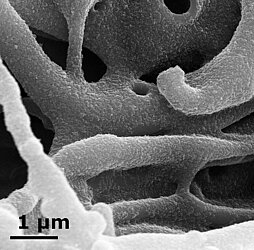The removal of micropollutants from water is one of the greatest global challenges. A majority of micropollutants are endocrine disruptors that influence basic human functions such as behavioral development and fertility. For example, steroid hormones cause sex change in male fish and endanger reproduction. Hormones get into our water in a variety of ways, they are excreted naturally by humans and are used in agriculture and for medical therapies.
Scientists at the IOM in the field of research "Surfaces of Porous Membrane Filters" developed a method for coating polymer membranes with highly active TiO2. Steroid hormones could be successfully degraded with the porous photocatalytically active membrane in a continuous single-pass mode. The degradation tests in a photocatalytic flow-through reactor were carried out by the long-standing cooperation partner from the Institute for Advanced Membrane Technology (IAMT) at the Karlsruhe Institute of Technology (KIT) under the direction of Prof. Dr.-Ing. Andrea Iris Schäfer and M.Sc. Shabnam Lotfi.
Due to the nanoporous structure of the photocatalytic membrane, the contact between the hormone and the catalyst is significantly improved, so that even very low but environmentally relevant concentrations in the ng l‑1 range are effectively degraded. The influence of the water quality and operating parameters such as pH, temperature, flux, light intensity, and hormone concentration have been extensively studied. Electrostatic attraction and repulsion as well as the adsorption of hormones to the membrane have a major impact on the effectiveness of the degradation of steroid hormones. In this study, almost complete removal of estradiol (100 ng l‑1, 94% removal) could be achieved in just a single pass (60 l m‑2 h‑1). Dr. Kristina Fischer and Dr. Agnes Schulze from the IOM expect further increase in effectiveness and insights into the degradation of hormones in a continuous single-pass mode by adapting the pore structure of the membrane.
The results of the study were published in the renowned journal Nature Nanotechnology. Details and extensive information can be found there:
Lotfi, S., Fischer, K., Schulze, A., & Schäfer, A. I. (2022). Photocatalytic degradation of steroid hormone micropollutants by TiO2-coated polyethersulfone membranes in a continuous flow-through process. Nature Nanotechnology, 17(4), 417-423. DOI:10.1038/s41565-022-01074-8
Furthermore, the following publication in the Nature Nanotechnology Journal under the header News & Views offers a summary and overview of the publication:
Giorno, L. (2022). Membranes that filter and destroy pollutants. Nature Nanotechnology, 17(4), 334-335. DOI:10.1038/s41565-021-01064-2

